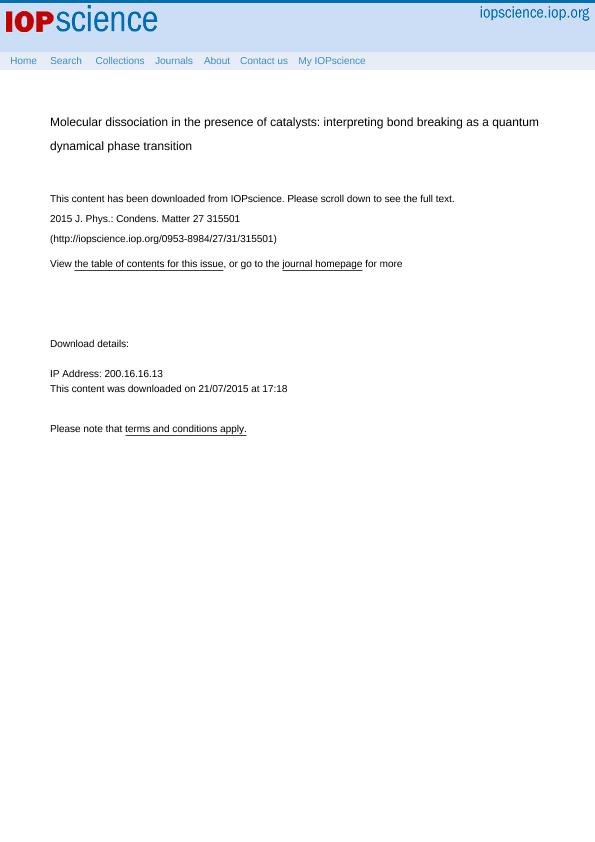Mostrar el registro sencillo del ítem
dc.contributor.author
Ruderman, Andres

dc.contributor.author
Dente, Axel Damián

dc.contributor.author
Santos, Elizabeth del Carmen

dc.contributor.author
Pastawski, Horacio Miguel

dc.date.available
2023-01-26T13:06:54Z
dc.date.issued
2015-08
dc.identifier.citation
Ruderman, Andres; Dente, Axel Damián; Santos, Elizabeth del Carmen; Pastawski, Horacio Miguel; Molecular dissociation in the presence of catalysts: Interpreting bond breaking as a quantum dynamical phase transition; IOP Publishing; Journal of Physics: Condensed Matter; 27; 31; 8-2015; 1-7
dc.identifier.issn
0953-8984
dc.identifier.uri
http://hdl.handle.net/11336/185734
dc.description.abstract
In this work we show that molecular chemical bond formation and dissociation in the presence of the d-band of a metal catalyst can be described as a quantum dynamical phase transition (QDPT). This agrees with DFT calculations that predict sudden jumps in some observables as the molecule breaks. According to our model this phenomenon emerges because the catalyst provides for a non-Hermitian Hamiltonian. We show that when the molecule approaches the surface, as occurs in the Heyrovsky reaction of H2, the bonding H2 orbital has a smooth crossover into a bonding molecular orbital built with the closest H orbital and the surface metal d-states. The same occurs for the antibonding state. Meanwhile, two resonances appear within the continuous spectrum of the d-band, which are associated with bonding and antibonding orbitals between the furthest H atom and the d-states at the second metallic layer. These move toward the band center, where they collapse into a pure metallic resonance and an almost isolated H orbital. This phenomenon constitutes a striking example of the non-trivial physics enabled when one deals with non-Hermitian Hamiltonian beyond the usual wide band approximation.
dc.format
application/pdf
dc.language.iso
eng
dc.publisher
IOP Publishing

dc.rights
info:eu-repo/semantics/openAccess
dc.rights.uri
https://creativecommons.org/licenses/by-nc-sa/2.5/ar/
dc.subject
ATOMS
dc.subject
MOLECULE
dc.subject
TRANSITION
dc.subject.classification
Física de los Materiales Condensados

dc.subject.classification
Ciencias Físicas

dc.subject.classification
CIENCIAS NATURALES Y EXACTAS

dc.title
Molecular dissociation in the presence of catalysts: Interpreting bond breaking as a quantum dynamical phase transition
dc.type
info:eu-repo/semantics/article
dc.type
info:ar-repo/semantics/artículo
dc.type
info:eu-repo/semantics/publishedVersion
dc.date.updated
2023-01-23T16:40:25Z
dc.identifier.eissn
1361-648X
dc.journal.volume
27
dc.journal.number
31
dc.journal.pagination
1-7
dc.journal.pais
Reino Unido

dc.journal.ciudad
Londres
dc.description.fil
Fil: Ruderman, Andres. Universitat Ulm; Alemania. Consejo Nacional de Investigaciones Científicas y Técnicas. Centro Científico Tecnológico Conicet - Córdoba. Instituto de Física Enrique Gaviola. Universidad Nacional de Córdoba. Instituto de Física Enrique Gaviola; Argentina
dc.description.fil
Fil: Dente, Axel Damián. Invap S. E.; Argentina. Consejo Nacional de Investigaciones Científicas y Técnicas; Argentina
dc.description.fil
Fil: Santos, Elizabeth del Carmen. Universitat Ulm; Alemania. Consejo Nacional de Investigaciones Científicas y Técnicas. Centro Científico Tecnológico Conicet - Córdoba. Instituto de Física Enrique Gaviola. Universidad Nacional de Córdoba. Instituto de Física Enrique Gaviola; Argentina
dc.description.fil
Fil: Pastawski, Horacio Miguel. Consejo Nacional de Investigaciones Científicas y Técnicas. Centro Científico Tecnológico Conicet - Córdoba. Instituto de Física Enrique Gaviola. Universidad Nacional de Córdoba. Instituto de Física Enrique Gaviola; Argentina
dc.journal.title
Journal of Physics: Condensed Matter

dc.relation.alternativeid
info:eu-repo/semantics/altIdentifier/url/https://iopscience.iop.org/article/10.1088/0953-8984/27/31/315501
dc.relation.alternativeid
info:eu-repo/semantics/altIdentifier/doi/http://dx.doi.org/10.1088/0953-8984/27/31/315501
Archivos asociados
